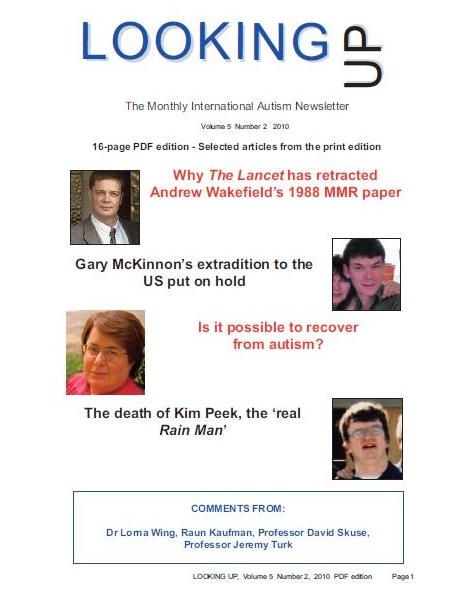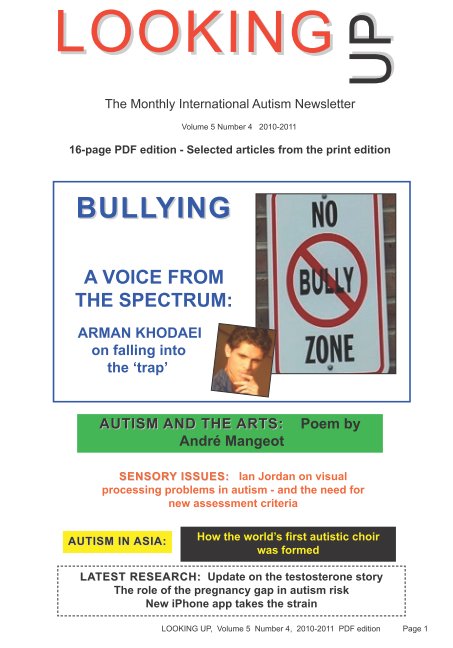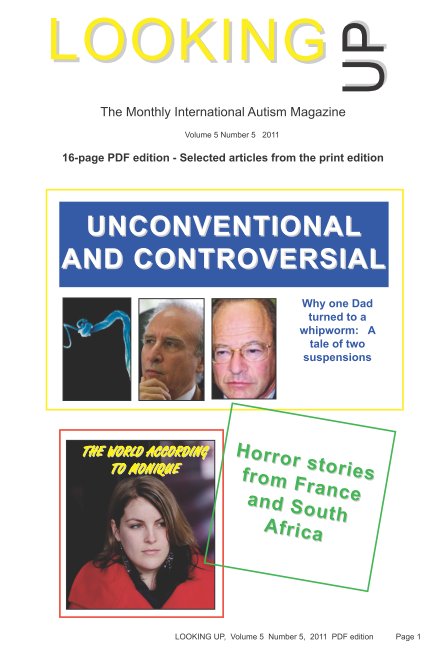Looking Up, 16-page English PDF Edition, Back Issues and Current Issue

|

|

|

|

|

|

|

|
| Home page | Subscribe (print edition) | Selected articles | Our publications | Our mailing lists |
| PDF edition | Subscribe (PDF edition) | Back issue contents | Autism books | Contact us |
From Volume 3 Number 1
My 14-year-old son, Víctor, was diagnosed with autism at the age of three by an official body. His paediatrician never detected any abnormality in his development and I never had the feeling that anything was wrong.
The diagnosis was the first news that Víctor was not developing normally, and it came as a great shock. He was a cheerful child who laughed a lot and never avoided contact with others. It’s true that he found it hard to pay attention and had no spoken language. He also had eating disorders and it was difficult to introduce solid food into his diet. It was also difficult to get him ready to go to sleep. He resisted being changed and cried until he fell asleep. It was as if he were panicking - but it never occurred to us that he could have autism.
The book which helped me the most in those difficult moments was undoubtedly Dr Ivar Lovaas’s guide for parents and teachers. In it, he explained in detail how to teach language to autistic children, and it gave me hope. Without losing any more time, I began to put the methods Dr Lovaas outlined into practice. I tried to teach Víctor some words, and in a few weeks he learnt to discriminate between various objects. I spent several months working with Víctor, but the lessons became more and more complicated and there came a point when we were no longer making much progress. Even so, Víctor had increased his vocabulary a lot and every new word came easier to him.
I found out about a special centre for autistic children, and we began to go there once a week. Months later, he started to combine his stay at the autism centre with a normal school. But at six, Víctor left the mainstream school completely and lost contact with normal children.
He was showing more and more autistic behaviour: he had tantrums and from time to time he was self-injurious. He bit his clothes, screamed and his hyperactivity increased - although it could be controlled to a certain extent.
He ate little and his diet was restricted to wheat products such as pasta, noodles, biscuits, etc, as well as dairy products. He also ate vast quantities of sweets, and and he went into a furious rage if we refused to give them to him.
As he approached the age of nine, his destructive behaviour increased considerably. He cried continually and had constant tantrums. He also suffered strong fits of depression and was almost always angry, raging against everything and everyone around him. We thought it would be a temporary phase, because we had already seen him go through some stages which were better than others. But in fact, his behaviour became more intense. He became more aggressive and began to bite his carers - even us. He broke windows at school and at home, sometimes hurting himself so badly that we had to take him to the doctor to have his injuries treated. He threw food at the ceiling and smeared his faeces all over the walls.
It was impossible to live with him - he had exceeded all the limits. Although I found it hard to believe that this was really happening to Víctor, in the end I was forced to give in, and, on the suggestion of his psychiatrist, we began to give Víctor Tranxillium. But instead of calming him down, this medication made him even more violent, until he had to be taken into the psychiatric service at the Children’s Hospital of San Juan de Dios here in Barcelona.
At the hospital, they gave him Sinogan, but even though this seemed to calm him down, soon afterwards he was breaking everything around again and attacking those who tried to stop him. His self-injurious behaviour became much more marked - something terrible was happening to him. It was horrible to see him tearing out his hair until he was almost bald, and biting his hands until they bled.
He needed several doses of medication one after another, and he even had to be put in a strait-jacket to stop him hurting himself and assaulting others.
He did calm down quite a lot after the huge doses of Sinogan that they administered to him, and a week later, he was given the all-clear and released from hospital.
From that moment on, we visited the psychiatrist frequently to control his medication. We had to change drugs several times. We added Haloperidol, but that didn’t work, so we started on Melleril, and there was point when Víctor’s eyes were almost closed from all the medication. The drugs did not produce positive changes in his behaviour, because he would go on breaking windows and attacking people.
For a year and a half, we made frequent visits to the Children’s Hospital. We did not know what to do with him, and, even though he was so young, we even considered the possibility that he might have to live away from home.
The psychiatrist mentioned a new drug which he thought he would try on our next visit, although it had rarely been tried on children so young and his liver would have to be watched carefully. He said he would make a decision on our following visit.
In the meantime, although I could not see how anything could help my son to escape from the chaotic worldin which he lived, I was lucky to receive a number of articles where they discussed a gluten- and casein-free diet to treat autistic children.
Ramón, a friend of the family, felt great affection for Víctor. Often, despite the difficulties, he would take him out for a walk in the park, and that gave me the chance to snatch a little rest. One day, Ramón appeared with more news about the diet. I couldn’t believe what I was reading: it seemed impossible that there could be a link between nutrition and autism. But there was no other option left. Without thinking twice, I removed wheat and dairy products from Víctor’s diet.
In just two days, Víctor appeared to be reacting positively. I heard that other foods could also be causing him harm, so we decided to do a complete analysis of food allergies. At the Great Plains Laboratory in Kansas, in the United States, apart from wheat and milk products, they detected other reactions. When we withdrew these from Víctor’s diet, within a month we saw spectacular changes.
On our next visit to the psychiatrist, he said that looking at Víctor was like looking at a different child and said there was no need to try the new medication he had proposed.
After five or six months, Víctor was able to stop taking the 136 drops of Sinogan and Melleril.
The diet had proved a huge success. In line with all the articles we could get hold of, we supplemented the diet with vitamins and trace elements, and from that moment on, we entered a new, much more hopeful phase. Although there were still ups and downs, life with our son was far easier than before.
Every week, Ramón showed up with new articles. I wanted to try the lot, to make sure Víctor continued to improve, So we did analyses of fatty acids, neurotransmitters, organic acids, etc. We also carried out vitamin A treatment in the form of cod liver oil with Urecholine. This produced another small improvement.
Then I became interested in sensory treatments.
At the end of 1999, we were involved in a car crash. Víctor’s father and myself were seriously injured, Víctor himself less so. That made us think: if we were no longer around, everything we were doing for Víctor could be interrupted.
That was when we came up with the idea of funding the Asociación para Vencer el Autismo (Association to Defeat Autism). Ramón is its president, and I was always be grateful for him to all the work he has been doing. When we started up less than a years ago, there were just 10 people involved from various parts of Spain - all with the same concerns. Today, we have more than 50 members, and we are fighting to introduce here in Spain the most advanced treatments for autism and pervasive developmental disorders.
I have also been lucky enough to get to know Dr Asún Puche, and through her, I have been able to try out the Lovaas method on Víctor. In just a few months, he has learnt to write and read, with some difficulties, and to draw. He is even doing sums. This would have been totally impossible before because of his behaviour. His language has inproved considerably, and he does small tasks around the house, like laying the table, picking up clothes, taking the rubbish out.
He is able to benefit from everything we teach him, and even though we started quite late - and this behavioural approach is more difficult in older children - the experience has been very positive. I profoundly regret not having been able to start it earlier.
There is still a lot left to do, and we continue to investigate further biological treatments in the hope that Víctor will make even more progress. I urge other parents of autistic children to do the same.
The Barcelona-based Association to Defeat Autism can be reached by telephone on: (+34) (93) 246 6242, or by e-mail: ana289@eresmas.com
To contact APNA (the Spanish national association of parents of autistic children) in Madrid, telephone: (+34) (91) 766 2222, or e-mail: apna@apna.es

|

|

|

|

|

|

|

|
| Current 40-page print edition issue | |||||||||||||||
|---|---|---|---|---|---|---|---|---|---|---|---|---|---|---|---|

|
| ||||||||||||||
| PRINT EDITION BACK ISSUE CONTENTS AND FRONT COVERS | ||||||||||||||||||||||||||
|---|---|---|---|---|---|---|---|---|---|---|---|---|---|---|---|---|---|---|---|---|---|---|---|---|---|---|
| VOLUME 1, Number: | 1 | 2 | 3 | 4 | 5 | 6 | 7 | 8 | 9 | 10 | 11 | 12 | VOLUME 2, Number: | 1 | 2 | 3 | 4 | 5 | 6 | 7 | 8 | 9 | 10 | 11 | 12 | |
| VOLUME 3, Number: | 1 | 2 | 3 | 4 | 5 | 6 | 7 | 8 | 9 | 10 | 11 | 12 | VOLUME 4, Number: | 1 | 2 | 3 | 4 | 5 | 6 | 7 | 8 | 9 | 10 | 11 | 12 | |
| VOLUME 5, Number: | 1 | 2 | 3 | 4 | 5 | 6 | 7 | 8 | ||||||||||||||||||
| You can find our PDF EDITION CONTENTS AND COVERS on our PDF EDITION BACK ISSUES PAGE | ||||||||||||||||||||||||||
| Home page | Subscribe (print edition) | Selected articles | Our publications | Our mailing lists |
| PDF edition | Subscribe (PDF edition) | Back issue contents | Autism books | Contact us |